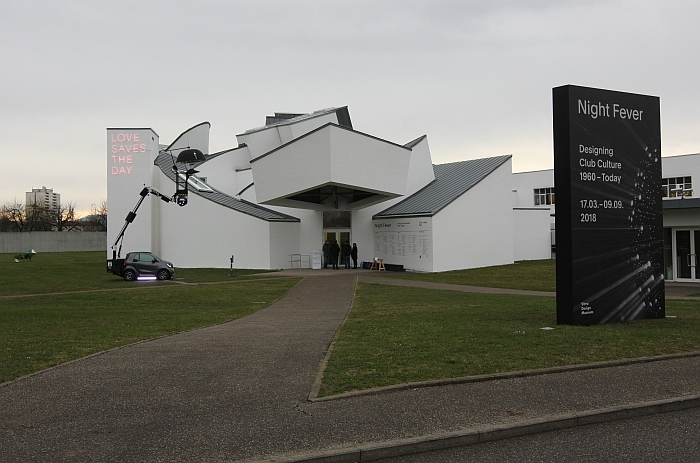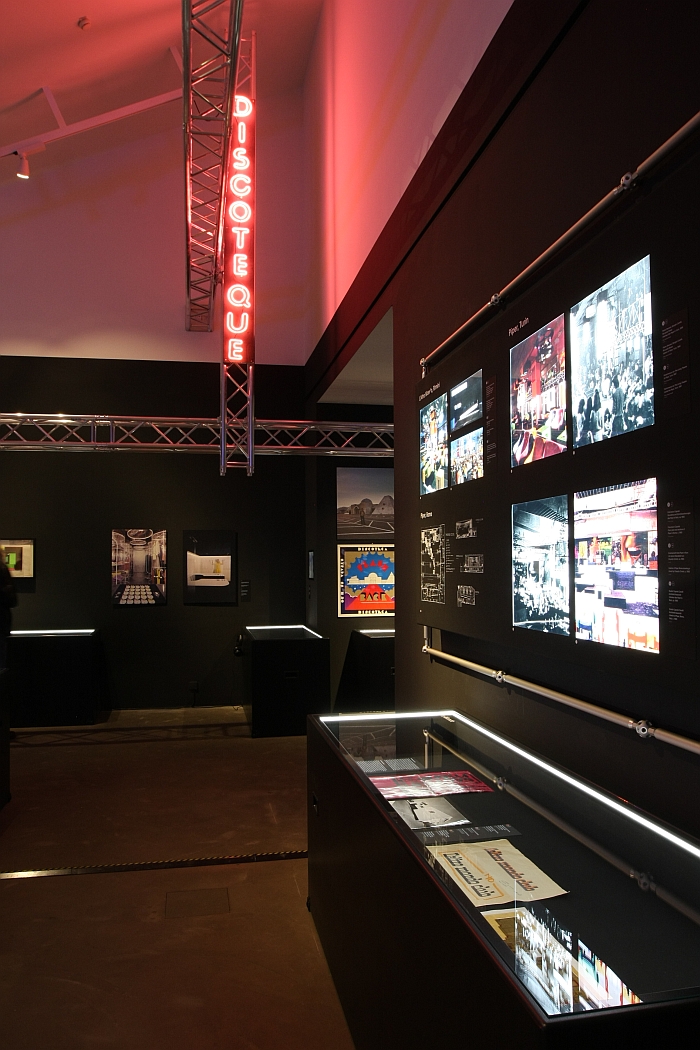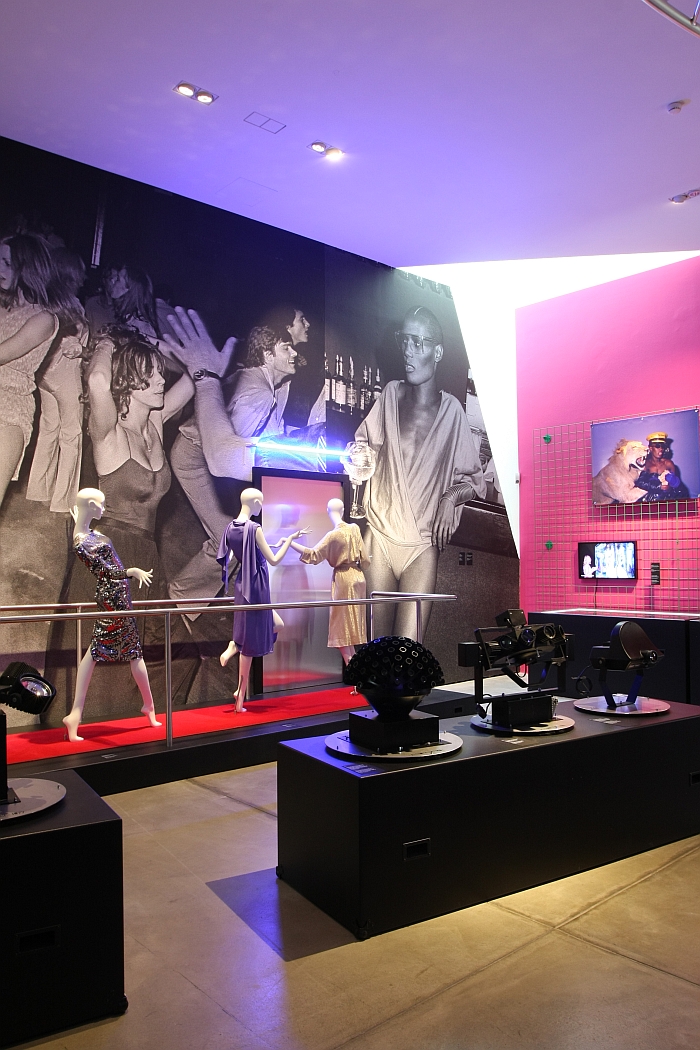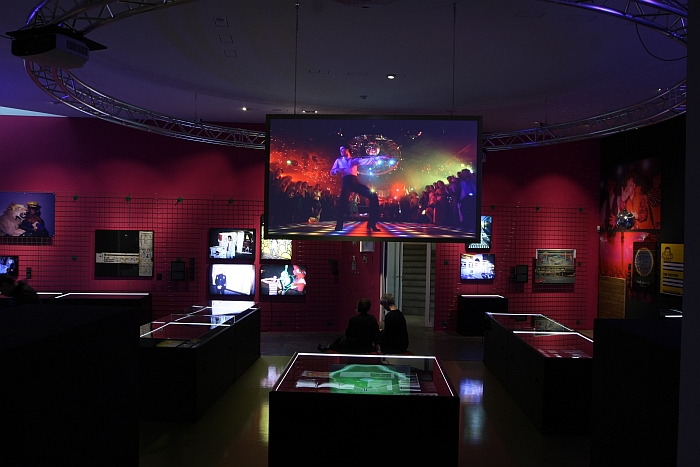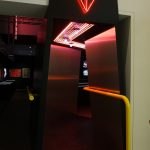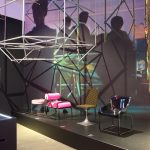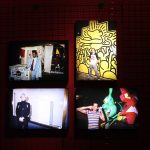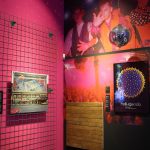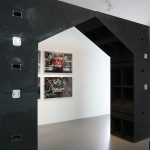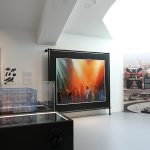Night Fever. Designing Club Culture 1960 – Today @ Vitra Design Museum
Nightclubs and discos are not only about entertainment and sensory overload, but also provide a society with means of expression and reflection.
With the exhibition Night Fever. Designing Club Culture 1960 – Today the Vitra Design Museum in Weil am Rhein explore five decades of club culture.
One of our worst ever disco experience’s was in Weil am Rhein. And we weren’t even there. It was a couple of years ago, we were in town as part of another project and had planned a night’s sleep after a hard day down the library. That same night a pub near our accommodation planned a disco. Until 5 am. The pub won and thus although much like Daft Punk’s muse we were up “’til the sun”, it wasn’t “good fun” and there was certainly no getting lucky.
Night Fever. Designing Club Culture 1960 – Today at the Vitra Design Museum is an altogether more satisfying disco experience.
Although at first it may appear odd for an institution such as the Vitra Design Museum to explore a subject such as club culture as museum director Mateo Kreis states there are three, principle, reasons why it not only makes sense but is sensible that an institution such as the Vitra Design Museum should explore such a subject: clubs represent outstanding memorable experiences in many people’s lives, and as such are a subject that most of us can relate to; nightclubs reflect changes in society, present an image of a given society; and nightclubs are closely related to artistic avant-garde movements and thereby help explain that design is about creating the moment, creating society and creating experience. In its attempt to explain these, and other aspects of the nightclub Night Fever takes the visitor on a chronological tour through five decades of club culture, a tour which not only explains how nightclubs have evolved over the years, but how they have also remained essentially the same.
Opening in the 1960s with an exploration of the origins of what one today understands as the “nightclub”, including Electric Circus in New York or Space Electronic in Florence and Piper in Turin, the latter two of which were closely related to the Italian Radical Design movement of that period, the exhibition moves on to the seventies and eighties and venues such as Studio 54 New York, Area New York or Hacienda Manchester before ending in the 1990s and 2000s as represented by the likes of Tresor Berlin, B018 Beirut or Geneva based architects Bureau a’s “The Club”, one of several mobile, temporary club concepts presented in Night Fever.
Documenting club culture is in many ways not as straightforward as documenting other aspects of design and architectural history, not least because, as Meteo Kreis underscores, clubs are largely about the personal experience; clubs exist independent of the physical fabric and furnishings. While the ephemeral nature of clubs, that fact that many exist in a moment and thus come and go with alarming speed, means that more often than not after the club ceases to exist, the physical fabric and furnishings also cease to exist. Where, for example, the Manchester Hacienda once invited the youth of Britain to dance as if there was no tomorrow, now stand flats where couples watch soap operas of an evening before arguing over who is to take out the rubbish.
What physically remains of clubs is largely relatively dry: flyers, magazine articles, photos in varying degrees of focus, signage etc, etc, etc. Which is exactly what Night Fever principally presents, supported by technical equipment such as spotlights, mixing desks and glitter balls, clothing and a few rare surviving examples of club interiors including chairs, part of the Hacienda floor and the plasma ball from Tresor Berlin. Despite such limitations the exhibition design concept by Konstantin Grcic manages to create a well paced, accessible, presentation which treads a very well balanced line between an academic consideration of the subject and a celebration. For an exhibition about club culture Night Fever is very, very dry, which isn’t to say unentertaining, it is, is very much an entertaining presentation full of life, passion and atmosphere. Just the life, passion and atmosphere of others presented in a museum context.
That said there is one moment when it leaves the life, passion and atmosphere of others and allows the visitor to experience their own. The second room is given over to an installation by Konstantin Grcic in conjunction with the lighting designer Matthias Singer and the Cologne based DJ and musician Steffen Irlinger: an instillation which in effect sees the visitor leave the museum, leave the exhibition and enter that enduring symbol of nightclubs: The glitter ball! Surrounded by mirrors and light and listening to one of four play lists through headphones the visitor enters the essence of the nighclub, and an installation which through its abstract reduction underscores how essentially non-existent a nightclub is, that a nightclub is personal experience.
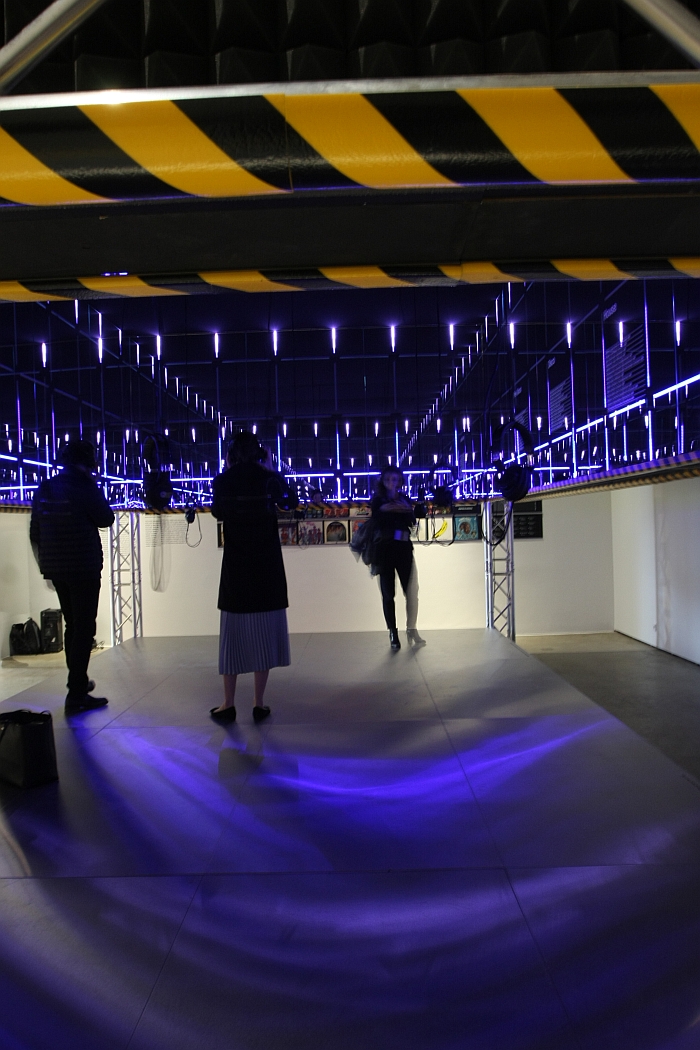
Inside the glitter ball, as seen at Night Fever. Designing Club Culture 1960 – Today, Vitra Design Museum
The personal nature of the nightclub experience is not just how good or bad the previous evening/weekend was, but also what the club represents to you, nightclubs being not only palaces of entertainment but both places of escape and places of confirmation; places where you can confirm your status, tribe affiliation, sexual or gender orientation, yet parallel also locations where you can slip into another life, become that person you are not in your daily life, which allow you to escape the realities of your hopeless existence for a few short hours, much like John Travolta a.k.a Tony Manero in Saturday Night Fever, a clip of which is on constant loop in the room 3.
As Night Fever makes very clear nightclubs have always had this dual function, existing as the do on the edge of polite society, just far enough away from convention to guarantee the necessary freedom and security, and a dual functionality that has been important in helping society develop and evolve as positions, ideas and movements have moved from the underground of the club to the mainstream of society.
Night Fever also makes very clear that despite the underground associations with clubs, clubbing has always been a commercial business, the clubs featured in Night Fever are, for all their “cult” status, examples of the development of a very successful business model, one that transcends time and culture, because it is about selling experience, belonging, fantasy, is about providing an appropriate space for cultural phenomenon to exist, unfold and express themselves, is about making money from people dancing and socialising. And there is a lot of money to be made from people dancing and socialising. And a lot of people keen to make that money.
A further constant in the story of club culture, yet one not covered in Night Fever, is the stimulants. In the exhibition texts one can read that “The effect of the allatoncenesss of the technological sensory overload was deliberately evoked in the clubs and occasionally intensified by drug use” Our only argument with that sentence would be the use of the word “occasionally”. While “always” or “universally” would be equally incorrect, there is no denying the central role drugs always have and still do play in club culture. Although as a general rule we don’t comment on that which we consider “missing” from exhibitions, brining as it does an unnecessary subjective element to the curators complex objective considerations; for our part we find it a shame that Night Fever doesn’t explore drugs culture because they are not only central to club culture, but also to many of the personal experiences of clubbing, experiences which are the reason some of those who called the featured clubs home are no longer amongst us and can’t share in the memories.
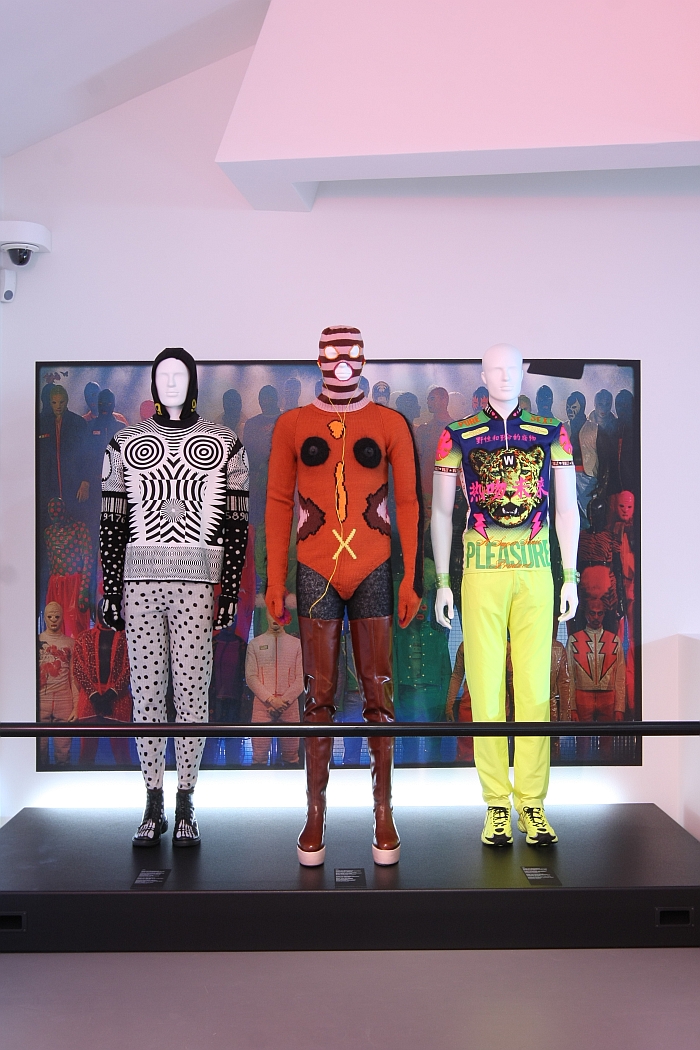
Brings back memories! Club clothing by Walter Van Beirendonck, as seen at Night Fever. Designing Club Culture 1960 – Today, Vitra Design Museum
It goes without saying that not only have a majority of us never visited the clubs featured in Night Fever, but an even greater majority have/would have had no interest in visiting them.
Does that make the clubs, and by extrapolation the exhibition, irrelevant?
Far from it.
On the one hand nightclubs and club culture aren’t just the clubs featured, they are also small specialist music venues, or the local village disco, and on the other there are reasons the clubs featured became such bywords for their age: they were culturally relevant, socially relevant, were reflective of a society, or at least an aspect of a society, at a period in its evolution: the articles, for example, in Italian architecture magazines Casabella and Domus describing in detail the interiors of the clubs of the 1960s indicating how serious they were taken at a time when Italy was slowly awakening from its post-War traumas; Studio 54 may be a byword for 1970s debauchery, but the disco culture it helped popularise helped change attitudes towards sexual and racial equality, when not necessarily achieving such fully; while clubs like Tresor or the Hacienda were, in certain regards, about a disenfranchised youth claiming part of a disintegrating society for themselves, something the authorities couldn’t take because they had no access to it.
As an exhibition Night Fever cannot possibly hope to fully explain the social and cultural impact and influence of global club culture across five decades; and if it attempted to it would be as unwieldly as it were dull. Much more as an exhibition Night Fever provides the introduction, the impetus to explore more deeply. And to go out dancing more often.
In context of the V&A London’s 2012 exhibition British Design 1948-2012. Innovation in the Modern Age* we noted that all the post-war developments in UK design were inexplicably linked with youth sub-cultures, until the mid-1990s when thanks to the internet youth sub-cultures became impossible: the speed at which ideas are transported meaning that they are snubbed out before they can become something tangible, something like Rave, which in our opinion was the last real youth sub-culture.
Regardless of where one draws the line there is no arguing that the dynamics of cultural development have changed since the internet became all pervasive, and while club culture may not be exactly equal to youth sub-culture, there are parallels, parallels which of course pose questions about the future of nightclubs and club culture.
As much as being an exploration of the history of club culture Night Fever is also, when not explicitly conceived as such, a look at the future, a future where, for us, and despite the rise of alternatives, super clubs will continue making their super profits because there will always be those who want to be on the list, get past the bouncer or who simply have the cash to flash. And a future where for all the small club, the underground, the avant-garde, the experimental club will continue to play their important role; where the clubbing experience will, as with the fields and abandoned warehouses of early rave, be less about the location and all about the experience; there will always be those who need the escape and confirmation only a club can offer; and also that in our increasingly digital, algorithm defined, world there will be those who want to hear music selected by a specialist who cares as much as they do, who want to hear something special. And when that connects with society’s current ills and passions, something unique and temporal can,will arise.
And so who knows, maybe if in 20 years the Vitra Design Museum host an update of the Night Fever we can puff our chests and boast how two decades previously we’d been part of the start of a radical new club culture developed in the mean backstreets of Weil am Rhein.
Night Fever. Designing Club Culture 1960 – Today runs at the Vitra Design Museum, Charles-Eames-Straße 2, 79576 Weil am Rhein until Sunday September 9th.
Full details, including information on the accompanying fringe programme can be found at www.design-museum.de
*Reading that post again we realise we have at several points confused style with design…. which is very embarrassing but, we were young, still had our own teeth and everything.
- The entrance to Night Fever via, more or less, the entrance to Superstudio’s 1960s Mach 2 club in Florence
- Examples of chairs created for 1960s nightslubs, as seen at Night Fever. Designing Club Culture 1960 – Today, Vitra Design Museum
- Jean-Michel Basguiat, Keith Haring, Andy Warhol and Kenny Sharf hotographed by Volker Hinz, as seen at Night Fever. Designing Club Culture 1960 – Today, Vitra Design Museum
- Night Fever. Designing Club Culture 1960 – Today, Vitra Design Museum
- Loud speaker modules from Bureau a’s 2016 project “The Club”, as seen at Night Fever. Designing Club Culture 1960 – Today, Vitra Design Museum
- Night Fever. Designing Club Culture 1960 – Today, Vitra Design Museum
Tagged with: glitter ball, Konstantin Grcic, Night Fever. Designing Club Culture 1960 - Today, Nightclub, Vitra, Vitra Design Museum, Weil am Rhein
